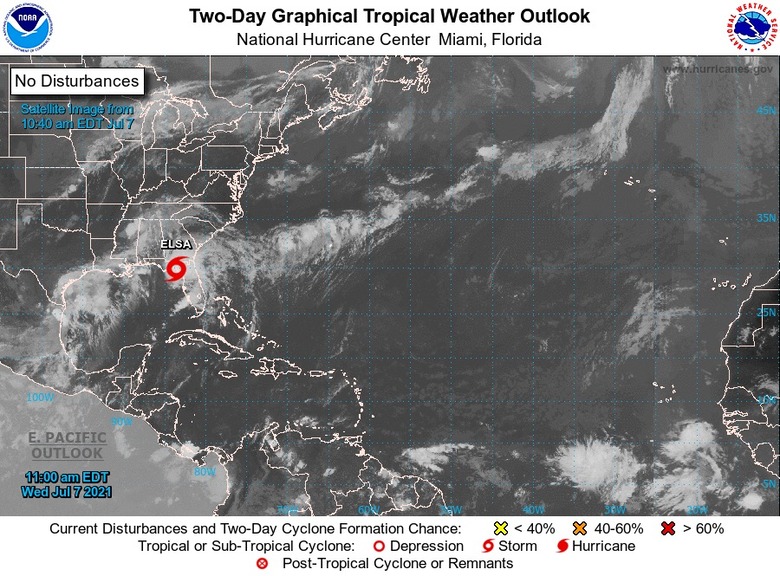Tropical Storm Elsa Hits Land: Staying Safe With NOAA And FEMA Alerts
Tropical Storm Elsa has reached the Florida coast, with the National Oceanic and Atmospheric Administration (NOAA) warning of up to 65 mph winds and issuing a Tropical Storm Warning. According to weather forecasts, Elsa is expected to move north through Wednesday afternoon, July 7, before shifting further inland.
"A turn toward the north-northeast is expected late this afternoon or tonight, followed by a faster northeastward motion by late Thursday," the NOAA said today. "On the forecast track, Elsa will continue to move inland into Florida this afternoon. The storm should then move across the southeastern and mid-Atlantic United States through Thursday."
The NOAA has adjusted its weather warnings accordingly, including canceling the Storm Surge Watch for the Florida Gulf coast. That's now been downgraded from a hurricane warning to a Tropical Storm Warning. Still, there could be gusts of wind above 65 mph.
While it seems Elsa may not be as serious as first feared, that's not to say there'll be no impact. Storm surge flooding could still take place, and there are "considerable flash and urban flooding" risks according to the NOAA. Rainfall up to 9-inches in some areas are predicted.

"A few tornadoes are possible today and tonight across northern Florida and southeastern Georgia into eastern South Carolina," the NOAA warns. "The tornado threat should shift to the eastern Carolinas and far southeast Virginia on Thursday."
NASA released an image of Tropical Storm Elsa as it passed through the Caribbean Sea. Taken by astronaut Megan McArthur from the International Space Station, it shows the huge mass of clouds as they approached the east coast.
Tracking Tropical Storm Elsa
With the forecast for Elsa so variable, the recommendation is that those potentially at risk from the tropical storm should make sure they're getting the latest alerts from the NOAA, FEMA, and other organizations.
The FEMA mobile app, for example, is a free download for iOS and Android devices. It includes real-time alerts for up to five locations across the US, and the ability to share real-time notifications with others. In the case of an emergency, it includes the location of emergency shelters and disaster recovery centers.
FEMA also operates a text messaging service, which can be used to locate emergency support even if you don't have an internet connection. Texting "SHELTER" and your ZIP code to 43362, for example, will return a list of open shelters for disaster survivors. Texting "DRC" and your ZIP code to 43362 will return a list of official Disaster Recovery Centers.
Sending "STOP" to 43362 unsubscribes your number from any FEMA text messaging alert.
